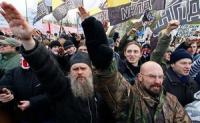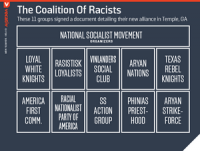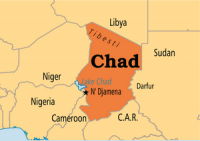-
Unprecedented levels of cross-border cooperation among extreme right groups: Report

New research released the other day by ISD, a counter-extremism NGO, reveals increasing collaboration among extreme far-right groups globally. The report shows how extreme right groups have been opportunistically, and effectively, bridging ideologies and adapting their tone to manipulate legitimate social grievances – immigration, freedom of speech, and terrorism – in order to reach and radicalize mainstream parties and movements.
-
-
Are many hate crimes really examples of domestic terrorism?
This growing domestic menace deserves more attention than it’s getting. I consider domestic terrorism a more significant threat than the foreign-masterminded variety in part because it is more common in terms of the number of attacks on U.S. soil. The number of violent attacks on U.S. soil inspired by far-right ideology has spiked since the beginning of this century, rising from a yearly average of 70 attacks in the 1990s to a yearly average of more than 300 since 2001. Despite an uptick in far-right violence and the Trump administration’s plan to increase the Department of Homeland Security budget by 6.7 percent to $44.1 billion in 2018, the White House wants to cut spending for programs that fight non-Muslim domestic terrorism. The federal government has also frozen $10 million in grants aimed at countering domestic violent extremism. This approach is bound to weaken the authorities’ power to monitor far-right groups, undercutting public safety.
-
-
Normalizing white nationalist hate

A panel of experts met last week at Harvard University’s Kennedy School (HKS) to examine the U.S. white nationalist movement’s rise to prominence and discuss ways to counter it. One panelist was R. Derek Black, a former white nationalist activist whose father, Don Black, created Stormfront, the internet’s first and largest white nationalist site. When the moderator asked whether white nationalists tended to be seen as “people from Alabama,” Black replied that most of the stereotypes are inaccurate. “There’s a strange misconception that it’s a trailer park movement, or that it’s people who haven’t thought through their beliefs. But think about it. Who has the resources to travel across the country for rallies? It’s not a wealthy movement, but it’s bankers, lawyers, people with good jobs.”
-
-
New early-warning intelligence system alerts civilians to impending chemical attacks
Since 2011, the Assad regime has killed hundreds of Syrian, and injured thousands, through the use of chemical weapons. Chemical agents are different from explosive chemicals, which cause localized destruction through force. Sarin gas, for example, a nerve agent which has been used in many attacks in Syria, can diffuse into the atmosphere and spread for hundreds of miles. Researchers are working to develop an intelligence system for chemical plume trajectory tracking, which is critical for national safety against impending chemical threats.
-
-
Former foreign minister testifies in Argentinian terror cover-up probe
The former Argentinian foreign minister Hector Timerman testified in court on Tuesday under the allegations that Cristina Fernandez de Kirchner’s administration conspired with Iran to hide the Islamic Republic’s role in the 1994 bombing of the AMIA Jewish community center in Buenos Aires. The judicial investigation is based on the complaint of the late Argentinian prosecutor Alberto Nisman that Kirchner sought a secret deal with Iran in connection with the 1994 bombing.
-
-
Animal agriculture in U.S. increasingly threatened
The increasing rate of emerging and reemerging animal diseases, along with threats and attempts by those with nefarious intent to attack food and agriculture, point to the need to reduce the biological risk to America’s food and agricultural sector. That is the finding of a new report released Tuesday by the Blue Ribbon Study Panel on Biodefense.
-
-
U.S. not prepared to identify perpetrators of biological attacks: Expert panel
When violent attackers use biological agents to inflict harm, not only must law enforcement attribute the crime to the correct perpetrator, they must also identify the pathogens used and their sources exactly and quickly. That was the focus of a special meeting last week hosted by the Blue Ribbon Study Panel on Biodefense.
-
-
Why would the Trump administration ban travel from Chad?

To the surprise of many experts, the Trump administration’s revised travel ban removed Sudan – but added Chad, a Muslim majority country in the Sahel region of Africa. Chad’s inclusion has befuddled observers as well as the Chadian government and the African Union. Based on my experience working at the State Department, including a period of time when I was focused on the Sahel, I went looking for reasons that would lead the U.S. to ban Chadians. I found more questions than I was able to answer. Sanctioning a country that has been an ally to the United States on its top national security priority – terrorism – does serve as a red flag to other countries. Some countries will seek to stay on the United States’ good side. Others, especially in Africa, may eye China as an alternative, more reliable partner.
-
-
Detecting nuclear materials used in dirty bombs
Radiological material falling into the wrong hands is a constant security concern for governments around the world. Border agencies must scan incoming vehicles and freight for radioactive material, which is a challenging task, as huge volumes of both move across borders each day. Imperial College London’s physicists have developed two devices for detecting nuclear materials.
-
-
Terrorism and guns: Troubling implications for U.S.
According to the authoritative Global Terrorism Database (GTD), firearms accounted for about 55 percent of fatalities in terrorist attacks even though guns were used in less than 10 percent of terrorist events. Attacks involving more common weapons such as explosives, incendiary weapons and vehicles, or melee weapons had fewer fatalities than attacks involving firearms.Among industrialized countries, the United States has the highest proportion of terrorist attacks in which the perpetrators used firearms.
-
-
Changes needed to news coverage of mass shooters: Researchers
Reducing news coverage of rampage shooters’ personal information, like their names and photos, could be a deterrent to future mass shooters, according to researchers. The researchers identify three consequences of current news coverage, which typically includes publishing names and faces of mass shooters in initial and follow-up coverage: mass shooters’ fulfillment and incentive to achieve notoriety; competition among offenders to maximize victim fatalities; and copycat and contagion effects.
-
-
Days before LV shooting, DHS warned of threats by “lone offenders” to public events
On 20 September, only days before the Las Vegas mass shooting, DHS issued an 11-page report warning that “unaffiliated lone offenders” were one of the biggest threats to large public gatherings. The report did not refer to Las Vegas, but rather noted security concerns about public events – including sports events — in the South-Central areas of the United States. The 20 September report is similar to an unclassified, for-official-use-only “Joint Special Event Threat Assessment,” issued by DHS and the FBI in December 2016, which warned of the threats to public events in Las Vegas, especially New Year celebrations. “Unaffiliated lone offenders and [homegrown violent extremists] are of particular concern,” the document said.
-
-
Hamas refuses to disarm raising concerns of Hezbollah model in Gaza
Hamas has rejected the Palestinian Authority’s demand for disarmament and has vowed to hold onto its weapons to fight Israel. The terrorist group’s Politburo Chief, Ismail Haniyeh, said in an interview with Egyptian television that “there are two groups of weapons: There are the weapons of the government, the police and security services.”
-
-
Proposed budget cuts will weaken state, local ability to handle biological, chemical attacks
Looming budget cuts within DHS are doing little to qualm concern that state and local infrastructure is unprepared to handle a biological or chemical attack. “We are much better prepared than we were” post-9/11,” said one expert “But we are not where we need to be, and the progress is, in some cases, somewhat fragile.”
-
-
How America changed its approach to political Islam
The United States needs answers for questions not just about the nature of Islamist movements, but also about the more politically difficult question of what the United States should do about them. How the United States and Europe should respond—or even whether they should treat Islamist parties as distinctive in the first place—has been a contentious question since at least the early 1990s. The Arab Spring, two decades later, brought this “Islamist dilemma” back to the fore, and Washington found itself, again, conflicted.
-
- All
- Regional
- Water
- Biometrics
- Borders/Immig
- Business
- Cybersecurity
- Detection
- Disasters
- Government
- Infrastructure
- International
- Public health
- Public Safety
- Communication interoperabillity
- Emergency services
- Emergency medical services
- Fire
- First response
- IEDs
- Law Enforcement
- Law Enforcement Technology
- Military technology
- Nonlethal weapons
- Nuclear weapons
- Personal protection equipment
- Police
- Notification /alert systems
- Situational awareness
- Weapons systems
- Sci-Tech
- Sector Reports
- Surveillance
- Transportation
Advertising & Marketing: advertise@newswirepubs.com
Editorial: editor@newswirepubs.com
General: info@newswirepubs.com
2010-2011 © News Wire Publications, LLC News Wire Publications, LLC
220 Old Country Road | Suite 200 | Mineola | New York | 11501
Permissions and Policies
Editorial: editor@newswirepubs.com
General: info@newswirepubs.com
2010-2011 © News Wire Publications, LLC News Wire Publications, LLC
220 Old Country Road | Suite 200 | Mineola | New York | 11501
Permissions and Policies
